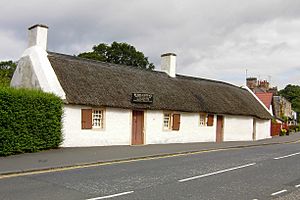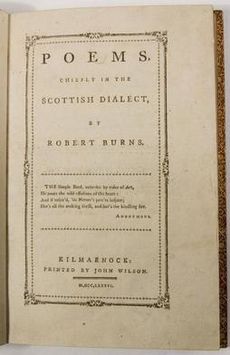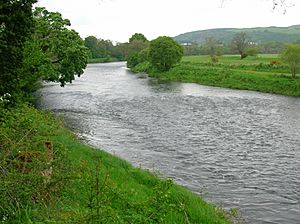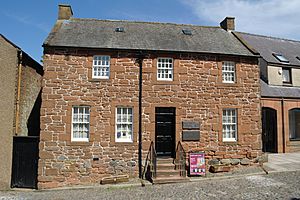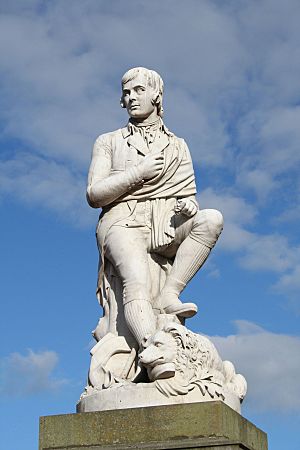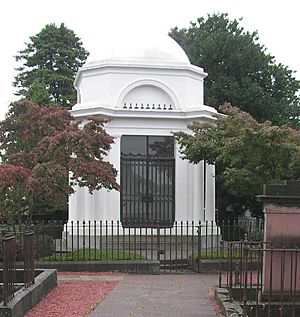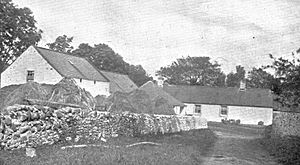Robert Burns facts for kids
Quick facts for kids
Robert Burns
|
|
|---|---|
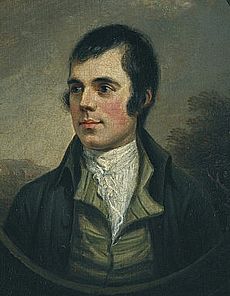
The best-known portrait of Burns,
by Alexander Nasmyth, 1787 (detail) |
|
| Born | 25 January 1759 Alloway, Ayrshire, Scotland |
| Died | 21 July 1796 (aged 37) Dumfries, Scotland |
| Occupation |
|
| Nationality | Scottish |
| Citizenship | British |
| Literary movement | Romanticism |
| Notable works |
|
| Signature | |
 |
|
Robert Burns (25 January 1759 – 1796) was a famous poet from Alloway, Ayrshire, Scotland. He is often called the national poet of Scotland. Many of his poems and songs are still well-known today.
His famous song Auld Lang Syne is sung around the world, especially on Hogmanay (New Year's Eve). Another important song, Scots Wha Hae, was once an unofficial national anthem for Scotland. Other popular works include A Red, Red Rose, A Man's A Man for A' That, To a Louse, To a Mouse, The Battle of Sherramuir, Tam o' Shanter and Ae Fond Kiss.
Burns wrote much of his work in Scots, which is a version of English. His song A Man's A Man For A' That was sung when the Scottish Parliament opened in 1999. Robert Burns died at the age of 37 and is buried in Dumfries, Scotland.
Contents
Early Life in Ayrshire
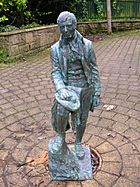
Robert Burns was born in Alloway, South Ayrshire, Scotland. He was the oldest of seven children. His father, William Burness, was a self-educated farmer. His mother was Agnes Broun.
He was born in a house his father built, which is now the Burns Cottage Museum. He lived there until he was seven years old. Life was hard, and he grew up in poverty. The farm work was very tiring.
Education and First Poems
Burns had little formal schooling. His father taught him reading, writing, math, geography, and history. He also had a tutor, John Murdoch, who taught him Latin, French, and mathematics.
By age 15, Burns was the main worker on the farm. In 1774, a young woman named Nelly Kilpatrick inspired his first poem, O, Once I Lov'd A Bonnie Lass. Later, he met Peggy Thomson, for whom he wrote two songs.
Moving to Tarbolton and Mauchline
In 1777, his family moved to a farm near Tarbolton. Burns continued to write poems and songs. He started a notebook for his writings in 1783.
After his father died in 1784, Robert and his brother Gilbert tried to keep the farm. When it failed, they moved to another farm near Mauchline.
Freemasonry and Fame
Robert Burns joined the Freemasons in 1781 when he was 22. He became an important member of his local lodge. In 1787, the Freemasons in Edinburgh named him the Poet Laureate of their lodge. This helped his name become known across Scotland and beyond.
The Kilmarnock Edition
His brother suggested that Robert publish his poems. In 1786, he published Poems, Chiefly in the Scottish dialect, also known as the Kilmarnock volume. This book was an instant success. It made him famous throughout the country.
Life in Edinburgh
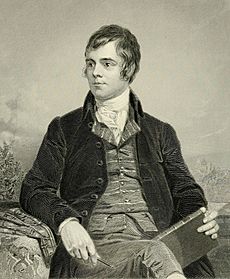
In 1787, Burns met James Johnson in Edinburgh. Johnson was a music engraver who loved old Scots songs. Burns shared this passion and helped Johnson with The Scots Musical Museum.
Burns contributed many songs to this collection. He was responsible for about a third of the 600 songs in the whole set. The last volume was published in 1803.
Life in Dumfries
Ellisland Farm and Excise Work
In 1788, Burns leased Ellisland Farm near Dumfries. He also trained to become an exciseman. An exciseman was an officer who collected taxes on goods. Farming was not easy, so he took on this job to earn money. He started working for Customs and Excise in 1789. He eventually gave up farming in 1791. During this time, he wrote some of his best works.
Writing Songs
Burns was asked to write lyrics for The Melodies of Scotland. He wrote over 100 songs for this project. He also contributed to other music collections.
He worked to collect and save old Scottish folk songs. He often changed or added to them. Many of his most famous poems are actually songs. For example, Auld Lang Syne uses the old tune Can Ye Labour Lea. A Red, Red Rose is set to the tune of Major Graham.
Family Life
Robert Burns had a large family, including nine children with his wife Jean Armour.
Death and Burial
Robert Burns died in Dumfries on 21 July 1796, at the age of 37. His funeral was held on 25 July 1796, the same day his son Maxwell was born. A special edition of his poems was published to help his wife and children.
He was first buried in St. Michael's Churchyard in Dumfries. Later, in 1815, his body was moved to its final resting place, the Burns Mausoleum, in the same cemetery. His wife, Jean Armour, was buried with him in 1834.
Honours and Legacy
Landmarks and Organisations
Burns's birthplace in Alloway is now a museum. His house in Dumfries is also a museum. There are many monuments and statues of him around the world.
Organisations like the Robert Burns Fellowship in New Zealand and the Burns Club Atlanta in the United States honor him. Some towns, like Burns, New York, are named after him. Even some trains have been named after him!
Stamps and Money
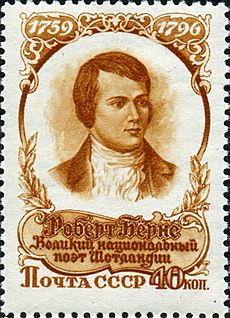
Russia was the first country to honor Burns with a stamp in 1956. He became known as the "people's poet" in Russia.
The Royal Mail in the UK has issued stamps honoring Burns three times. He is also pictured on the £5 banknote issued by the Clydesdale Bank in Scotland. In 2009, the Royal Mint made a special two pound coin with a quote from Auld Lang Syne.
Musical Tributes
In 1996, a musical about Burns's life, called Red Red Rose, won an award in Denmark. Another musical play about his love story with Nancy McLehose premiered in 2008.
Burns Suppers
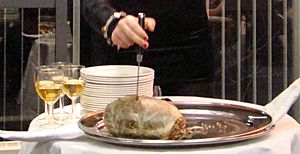
Burns Night is celebrated on his birthday, 25 January, with Burns suppers around the world. It is a very popular event in Scotland. The first Burns supper was held in 1802.
A Burns supper usually starts with a welcome and a prayer called the Selkirk Grace. Then, the haggis (a traditional Scottish dish) is brought in. Burns's famous "Address to a Haggis" is read, and the haggis is cut. After the meal, people give toasts, including a "Toast to the Lassies" and a toast to "the immortal memory" of Burns. The event usually ends with everyone singing "Auld Lang Syne".
Images for kids
-
Burns statue by David Watson Stevenson (1898) in Bernard Street, Leith
-
Alexander Nasmyth, Robert Burns (1828)
-
Burns Monument in Dorchester Square, Montréal, Québec
-
Burns statue in Treasury Gardens, Melbourne, Victoria, Australia
-
Statue of Burns and Luath, his Border Collie, in Winthrop Square, Boston, Massachusetts. It was moved back to its original location in the Back Bay Fens in 2019
See also
 In Spanish: Robert Burns para niños
In Spanish: Robert Burns para niños


